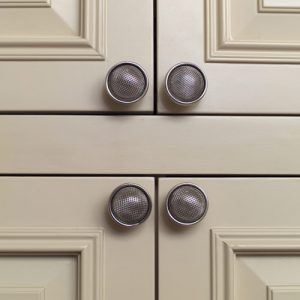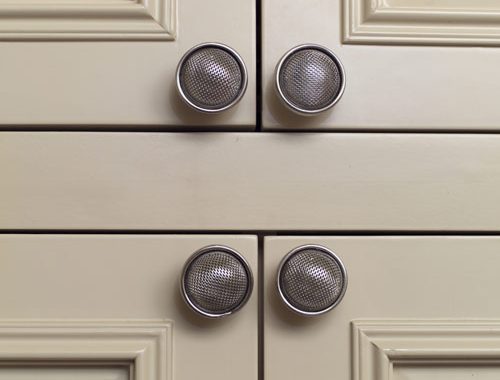 Did you know that the average cost of remodeling your kitchen is right around $20,000? Yes, $20,000. That’s a significant amount of money. So significant, in fact, that it means I won’t be doing any kitchen remodeling anytime soon. Sure, I’d like new cabinets or a new backsplash or a new floor, but we’re just too attached to having things like groceries and running water. And I don’t think we’re alone. A lot of people like groceries and running water. And yet, many of those same people also wish they had a better kitchen.
Did you know that the average cost of remodeling your kitchen is right around $20,000? Yes, $20,000. That’s a significant amount of money. So significant, in fact, that it means I won’t be doing any kitchen remodeling anytime soon. Sure, I’d like new cabinets or a new backsplash or a new floor, but we’re just too attached to having things like groceries and running water. And I don’t think we’re alone. A lot of people like groceries and running water. And yet, many of those same people also wish they had a better kitchen.
And that brings me to the good news: there are many things you can do that will help you update your kitchen without forcing you to give up those little luxuries we all like to have. Like food in the refrigerator. And one of those projects is painting your kitchen cupboards. If the doors and drawers are structurally sound, why rip them out and replace them? With a little elbow grease, some time, and the right products (I’m looking at you RepcoLite and Benjamin Moore), you can brighten them up and, in so doing, completely change the look and feel of your kitchen. And all for very little money!
If you think this project could be perfect for your kitchen, here’s what you need to do:
STEP ONE: Remove the hardware and hinges and label the doors with their location. Removing the hardware and taking the doors down requires no explanation. However, let me stress the importance of labeling the pieces. You definitely want to make sure you do this! Find a system that will work for you and make sure to mark each door and drawer as well as the place they go in the cabinet. Safe-release (Delicate Surface) painter’s tape works well. Just make 2 tags with a “1” and put one on the back of the door, and the other on the frame of the cabinet where the door goes. It’s a simple step, but will help you when it comes time to put things back together!
STEP TWO: Closely examine the surface of the cabinets and drawers and be sure to remove any peeling paint by sanding and scraping. Whatever paint remains on the surface of your cabinets must be sound! New paint brushed over a peeling surface won’t make that old layer stick. The old layer will continue to fail and will take the new one with it. So make sure that whatever paint you leave on the doors is adhering well. Also, if you have to scrape or sand off some of the paint, make sure that you spend some time feathering the bare spots into the spots where the paint remains.
STEP THREE: Clean the surfaces thoroughly. After taking care of loose, flaking, or peeling paint, you need to clean the surfaces with a mixture of 1 part TSP to 4 parts water. Kitchens are sources of many different surface contaminants and you need to make sure that the surface you’re painting is clean and free of grease, dirt, and so on. Use a Scotchbrite (“scrubby”) pad with the TSP to thoroughly clean the surfaces. And if you have some really stubborn dirt or grease, use the degreaser Spray Nine.
STEP FOUR: Scuff-sand the surfaces you’re going to paint. You can use an orbital sander for this, or you can do the sanding by hand. Either way, use either 180 – 220 grit sandpaper. The goal isn’t to sand through the current finish, it’s just to lightly scuff it. And when you’re done, remove all the dust from the cabinets. You can blow them off with an air compressor, vacuum the dust off, or wipe it off with a solvent like Denatured Alcohol or Xylene. However you remove the dust make sure that it’s all removed before moving on to the priming step!
STEP FIVE: Prime the cabinets with a good bonding primer. We recommend STIX Waterborne Primer. It will bond to the previous coating on your cabinets and will provide an excellent base for your topcoat! Let the primer completely dry and then assess the cabinets for any bleed-through of stain or tannins. This can happen if you’ve cut through the original coating while scuff sanding. If you do see some bleed through, spot prime those areas with an oil based primer or a white pigmented shellac like BIN.
STEP SIX: Topcoat with a good finish paint in either a satin sheen or a semi-gloss (for washability). If you’re brushing, we recommend giving Benjamin Moore’s Advance a try. It’s a waterborne alkyd which means you’ll get the performance of an oil-based product without the drawbacks. It will flow out remarkably well, providing you with a smooth finish even when you brush or roll the paint on. And, best of all, it cleans up with soap and water and doesn’t have the smell of an oil. Another great option is RepcoLite’s own Hallmark Ceramic. It rolls and brushes well and or can be sprayed. There are also a few other options we may recommend in the store, depending on your situation.
And that’s basically what you need to know. Yes, there is some work involved. Yes, it will take some time. You’ll have to do the sanding and the cleaning, the priming and the painting. But, when you’re done, you’ll be amazed at the difference in your home. And all for as little as $200 – $300 (or less!)
If you’re interested in this project, please email us with your questions or type your questions in the comment boxes on this post!


Can this be done with white laminate cabinets that have yellowed over time? Which of those two paints would serve us best? We have merillat white bay cabinets that are very dingy but otherwise sound.
Nancy
You certainly CAN paint over that laminate material, but there are a number of steps you’ve got to take to make sure that the project turns out as well as can be expected. Be aware that painting over a surface that smooth can definitely make it difficult for the paint to adhere. So, you’ve got to do the right amount of prep work to give it your best shot. And even then, there’s no guarantee there won’t be some chipping…
1. Make sure the laminate that’s on there is well-adhered and in good condition.
2. Wipe the surfaces down with Xylol or Denatured Alcohol. This will clean the surface of any contaminants that might be there. Ventilate well with either of them, but be extra careful with Xylol. Open windows, shut off pilot lights, etc.
3. Once you’ve wiped the doors down, make sure you scuff sand them with 150-grit to 180-grit sandpaper and then wipe them clean with whatever solvent you used earlier (you’ve got to remove the dust you created while sanding and this is the easiest way to do that!)
4. Next step is to prime them and we recommend Stix from Insul-x. You can pick it up at any RepcoLite and it’s made to bond to difficult to adhere-to surfaces, so it’s perfect for a job like this.
5. After that, it’s time for paint and either one of the products we mentioned in that podcast would be fine. Advance from Benjamin Moore is going to be shinier than the Hallmark (so bear that in mind). But either one will provide excellent durability, etc.
OK. Those are the steps. The big thing to remember is that the durability of the finished product will be directly related to the prep work you put in. Thanks for the question! If there’s anything else I can do, please let me know.
Would you recommend a clear-coat over the top coat of paint?
Hello Mary!
We would not recommend a clear coat on top. Any appropriate finish paint on cabinets will be just fine on their own. Layering more coats on can just cause problems down the road. RepcoLite’s Hallmark or Benjamin Moore’s Advance are great products for cabinets that will not require a clear top coat.
Hi. I was told at the store you don’t have to sand your cabinets if you use STIX. Which was the reason I bought it. Are you supposed to sand before and after using it?
Hello Debby,
While technically you can probably get by without sanding when you use Stix, we don’t recommend it. Sanding is a great insurance policy that what you paint with will stick as well as you want it to.
We are painting are kitchen cabinets they are light maple finish, we have lightly sanded then cleaned them and have applied one coat of stix, do you recommend more then one coat of primer? We are painted the cabinets a dark green color.
Hello Sue! We recommend just the one coat of primer. If you hadn’t put the primer on yet, you could have tinted it to a mid-tone gray to help with coverage, but since it’s on, I’d just go to your finish paint. You’re better to apply multiple coats to achieve full hide than you are to try to overload the paint and “make it work with one coat”! Applying too much paint will often result in a number of problems including a lot of drips and runs. Depending on the green you pick, you might get good hiding power. Just plan on a couple coats, maybe a third if necessary, and you’ll have better results in the long run!
Dan Hansen Betsy Thompson
What is the prep work for wanting to brighten my cabinets? What do I clean them with and what do I use? Gel stain? And then what do I finish it with? I tried cleaning with vinegar and water and that did nothing
Thank you
Janice
Hello Janice, the prep work required is based on what you’re trying to do. If you’re trying to get them ready to be painted, then it involves washing the cabinets down very well with a degreaser. You could use TSP or something like that. Then, rinse the doors very well and do a scuff sanding with a 220 grit sandpaper. Rinse the dust off with a damp rag. Then you should prime (STIX primer) and apply two coats of your chosen finish paint. (We like Advance from Benjamin Moore or RepcoLite’s own Hallmark).
If you’re trying to keep the stained and varnished look, you should still clean them very well to expose the areas that need some help. Probably just use a good spray on degreaser (Spray 9 works), or even a mild mixture of Dawn dish detergent and water. Just make sure to rinse the doors well with clean water to remove any residue from the cleaners. Once they’re clean and dry, you would then “buff in” a special gel stain. It takes a little practice, but the process goes relatively simply. If you’re only dealing with tiny dings and gouges, you may not need a finish coat over the gel stain. But if you’re doing a larger area or full doors, you’ll need to apply a couple coats of polyurethane over the doors to seal and protect the gel stain.
Understand that gel stain will help hide scratches and worn areas, but it won’t lighten the color of the doors. If anything, they could get a little darker.
We can gladly walk you through the project if you want to email us directly at radio@repcolite.com. The big thing is to stop out at any RepcoLite or Port City Paints with one of your cabinet doors so we can help you find the right gel stain. They’ll also be able to walk you through the project and give you more specifics. But, by all means, feel free to email us! Also, you can listen to us discuss this project on RepcoLite’s Home Improvement Radio Show. It’s here. Just fast forward to the second segment which starts at 10:45.